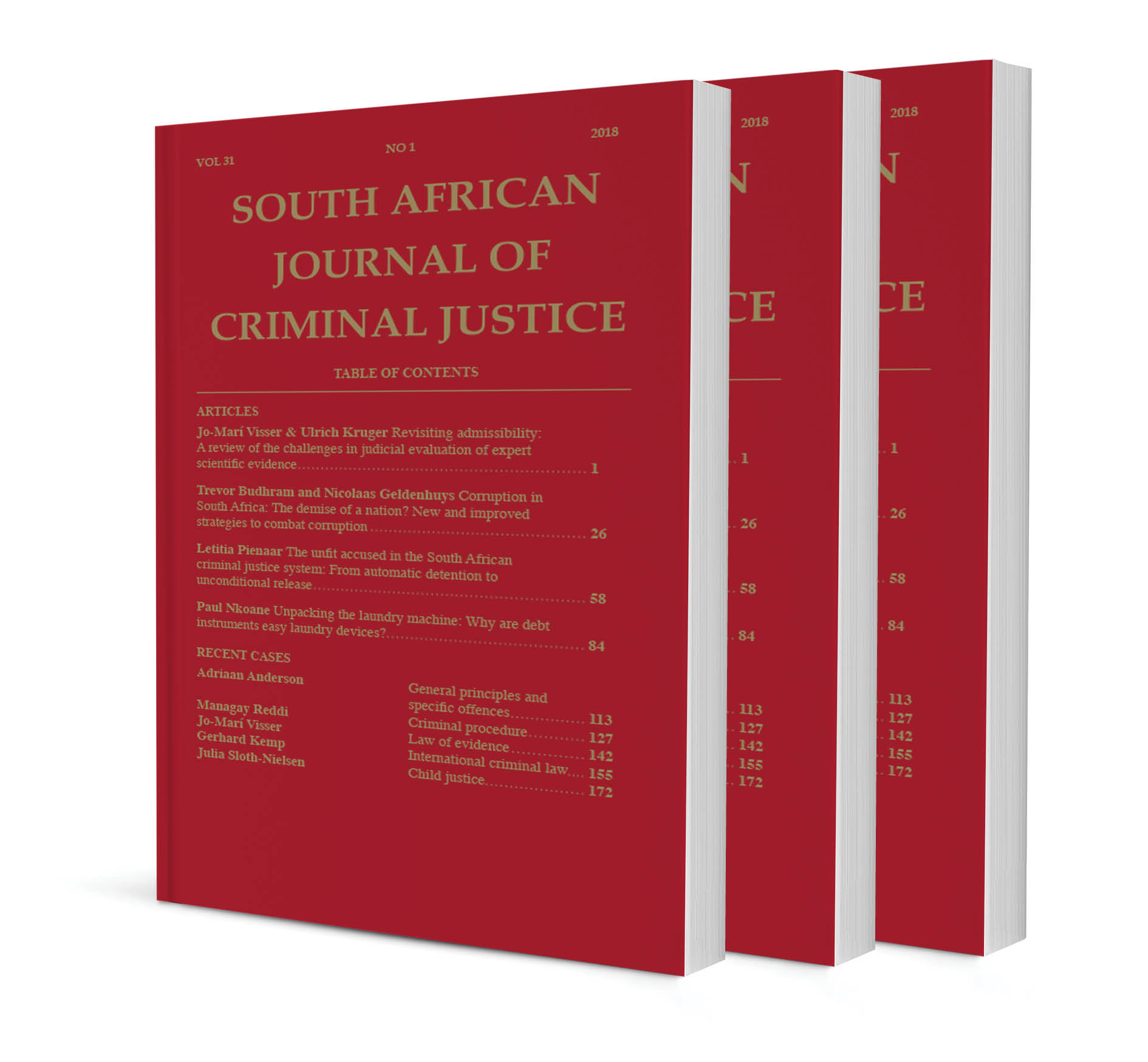Recent Case: Law of evidence

Recent Case: Law of evidence
Authors Jo-Mari Visser
ISSN: 1996-2118
Affiliations: University of the Free State
Source: South African Journal of Criminal Justice, Volume 29 Issue 3, p. 351 – 362
Abstract
None

ISSN: 1996-2118
Affiliations: University of the Free State
Source: South African Journal of Criminal Justice, Volume 29 Issue 3, p. 351 – 362
None

ISSN: 1996-2118
Affiliations: University of KwaZulu-Natal
Source: South African Journal of Criminal Justice, Volume 29 Issue 3, p. 339 – 350
None

ISSN: 1996-2118
Affiliations: None
Source: South African Journal of Criminal Justice, Volume 29 Issue 3, p. 333 – 338
None

ISSN: 1996-2118
Affiliations: Senior Lecturer, Law of Evidence: Department of Criminal and Procedural Law, UNISA, and Advocate of the High Court of South Africa; Lecturer, Law of Evidence: Department of Criminal and Procedural Law, UNISA
Source: South African Journal of Criminal Justice, Volume 29 Issue 3, p. 308 – 332
The change in course on the admission of extra-curial statements in S v Ndhlovu in 2000 caused concern about the correct way admissions of coaccused are to be admitted by the courts. Whilst many writers believed that s 3(1)(c) of the Law of Evidence Amendment Act 45 of 1988 accommodated admissions of co-accused against another, the case of Litako v S pointed out the anomalies that mitigated against that position. This article supports the view in Litako v S that corrected the earlier position of the court. It is the argument in this article that courts should not make out cases for the state and that it is the duty of the prosecution to establish a case to answer for each accused person, whether co-accused or not. It is further argued that the Law of Evidence Amendment Act never repealed the common-law principles regarding admissions, and that, if that were the case, the legislature should have expressly done so. Furthermore, it is argued that the approach in S v Ndhlovu opened too wide s 3 of the Law of Evidence Amendment Act.

ISSN: 1996-2118
Affiliations: None; Professor, Deputy Vice-Chancellor and Head of the College of Law and Management Studies, University of KwaZulu-Nata
Source: South African Journal of Criminal Justice, Volume 29 Issue 3, p. 292 – 307
While South African courts have frequently adjudicated matters involving tender irregularities, few findings of corruption have resulted from such cases. The courts appear constrained by strict rules pertaining to admission of evidence, which may result in their refusal to admit evidence of alleged corruption in cases involving tender appeals or reviews. This is notwithstanding the existence of judicial discretion bestowed upon courts through statute. Further, the provisions of the Prevention and Combating of Corrupt Activities Act (PCCAA) could be reformed to ease evidentiary burdens relating to the prosecution of corruption offences. Corruption often involves the exchange of undue gratification, and this may result in the accumulation of illicit wealth. The creation of an offence of possession of unexplained wealth is encouraged by international law, and may be credibly justified taking into account the nature of tender corruption. The creation of such an offence within the PCCAA may assist the prosecution from an evidentiary perspective — in that the prosecution would not be expected to prove that the wealth was obtained unlawfully. Cogent reasons exist for the appropriate reform of the PCCAA with respect to evidentiary issues pertaining to tender corruption. The nature of tender corruption, its prevalence in South Africa, and the difficulties associated with gathering evidence of corruption, justify such assistance from the legislature.

ISSN: 1996-2118
Affiliations: Associate Professor, Department of Public, Constitutional and International Law, University of South Africa
Source: South African Journal of Criminal Justice, Volume 29 Issue 3, p. 273 – 291
This article explores the concept of substantive equality and how, as a constitutional value, it requires the consideration and application of restorative justice principles in the sentencing of rape offenders. With sexual violence being a difficult and controversial area in which to apply restorative justice principles, there is a need to understand the necessity for its application and analyse how it has been applied by South African courts. The argument is made that restorative justice should be seen as a method that gives effect to substantive equality values, allowing for a victim’s needs and context (including that of the offender) to be taken into account in handing down a just sentence.